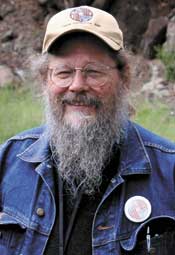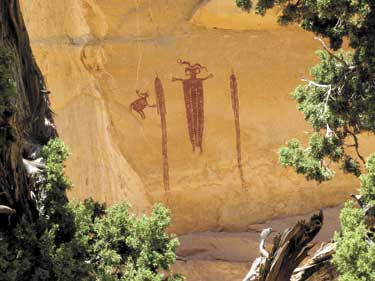MAY 6, 2015
Desert Foothills Chapter, Arizona Archaeological Society presents guest speaker David Wilcox May 15
 The Desert Foothills Chapter (DFC) of the Arizona Archaeological Society (AAS) is pleased to announce Dr. David Wilcox (r) an expert in southwestern archaeology as a lecturer on Wednesday, May 13. Doctor Wilcox completed a BA in anthropology at Beloit College in 1966, began graduate school at SUNY Albany, and finished his Ph.D. in Anthropology at the University of Arizona in 1977. In his earlier years, he worked on archaeology projects in Saskatchewan, was a New York State Archaeologist, graduate student representative of the Arizona Archaeological and Historical Society, and led a study of Tumamoc Hill (published in entire Kiva issue 1979). He also worked the Western Archeological and Conservation Center, National Park Service, as a visiting professor at Arizona State University, and Arizona State Museum before employment at the Museum of Northern Arizona in 1984, becoming head of its anthropology department (1988-2006) and retiring in 2010.
The Desert Foothills Chapter (DFC) of the Arizona Archaeological Society (AAS) is pleased to announce Dr. David Wilcox (r) an expert in southwestern archaeology as a lecturer on Wednesday, May 13. Doctor Wilcox completed a BA in anthropology at Beloit College in 1966, began graduate school at SUNY Albany, and finished his Ph.D. in Anthropology at the University of Arizona in 1977. In his earlier years, he worked on archaeology projects in Saskatchewan, was a New York State Archaeologist, graduate student representative of the Arizona Archaeological and Historical Society, and led a study of Tumamoc Hill (published in entire Kiva issue 1979). He also worked the Western Archeological and Conservation Center, National Park Service, as a visiting professor at Arizona State University, and Arizona State Museum before employment at the Museum of Northern Arizona in 1984, becoming head of its anthropology department (1988-2006) and retiring in 2010.
Southeastern Utah is especially famous archaeologically for its spectacular rock art panels, which date from at least the middle Archaic to the Historic period using both pictograph and petroglyph techniques. The people responsible for these panels and glyphs were Archaic hunter-gatherers that eventually adopted a form of agriculture with hunting. The Fremont Cultural Tradition is thought to be distinct from eastern and western Anasazi traditions, the Colorado River serves as the primary boundary line between them. Southeastern Utah is a “frontier zone” serving as a “periphery” or “buffer zone” where the Fremont sites of farmsteads or small hamlets contrast ceramically and architecturally with the farmsteads and hamlets of the Virgin, Kayenta and western Mesa Verde populations. The ramifications of political and economic developments by the Eastern Anasazi Tradition populations after 800 AD in the regions west and northwest of the Chacoan World on the Freemont people are an open scientific question as are the relationships of the Fremont populations to their eastern neighbors in the Wyoming Basin and Southern Rockies, and their Great Basin neighbors to the west. Archaeology of Southeastern Utah and Related Areas discusses these marginalized prehistoric populations in southeastern Utah.
 More recently, Dr. Wilcox worked extensively with the Verde Valley Archaeological Society, Arizona Site Stewards, and Verde Valley Archaeology Center as a proponent of avocational groups. He was named Arizona Archaeological Society Professional Archaeologist of the Year in 2008, received the 2007 Byron S. Cummings Award from the Arizona Archaeological and Historical Society, and 2009 the Arizona Governor's Lifetime Achievement Award. Doctor Wilcox’s is a past Chairman of the Arizona Archaeological Advisory Commission and served on the Crow Canyon Research Advisory Committee.
More recently, Dr. Wilcox worked extensively with the Verde Valley Archaeological Society, Arizona Site Stewards, and Verde Valley Archaeology Center as a proponent of avocational groups. He was named Arizona Archaeological Society Professional Archaeologist of the Year in 2008, received the 2007 Byron S. Cummings Award from the Arizona Archaeological and Historical Society, and 2009 the Arizona Governor's Lifetime Achievement Award. Doctor Wilcox’s is a past Chairman of the Arizona Archaeological Advisory Commission and served on the Crow Canyon Research Advisory Committee.
The general public may attend an Arizona Archaeology Society – Desert Foothills Chapter meeting at no charge, except for the holiday party in December. The AAS-DFC meetings are held on the second Wednesday of each month, September through May. There are refreshments available at 7 p.m. and the meeting begins at 7:30 p.m., usually ending prior to 9 p.m. The meetings are held in the community building (Maitland Hall) at The Good Shepherd of the Hills Episcopal Church, 6502 E.Cave Creek Road, Cave Creek.
www.azarchsoc.org/desertfoothills



